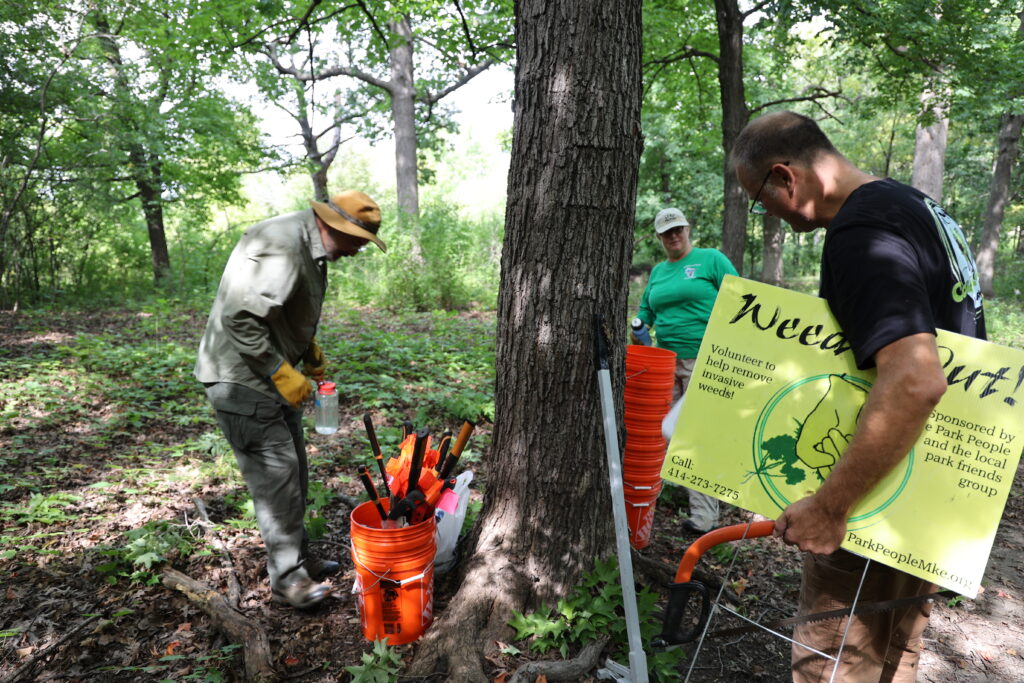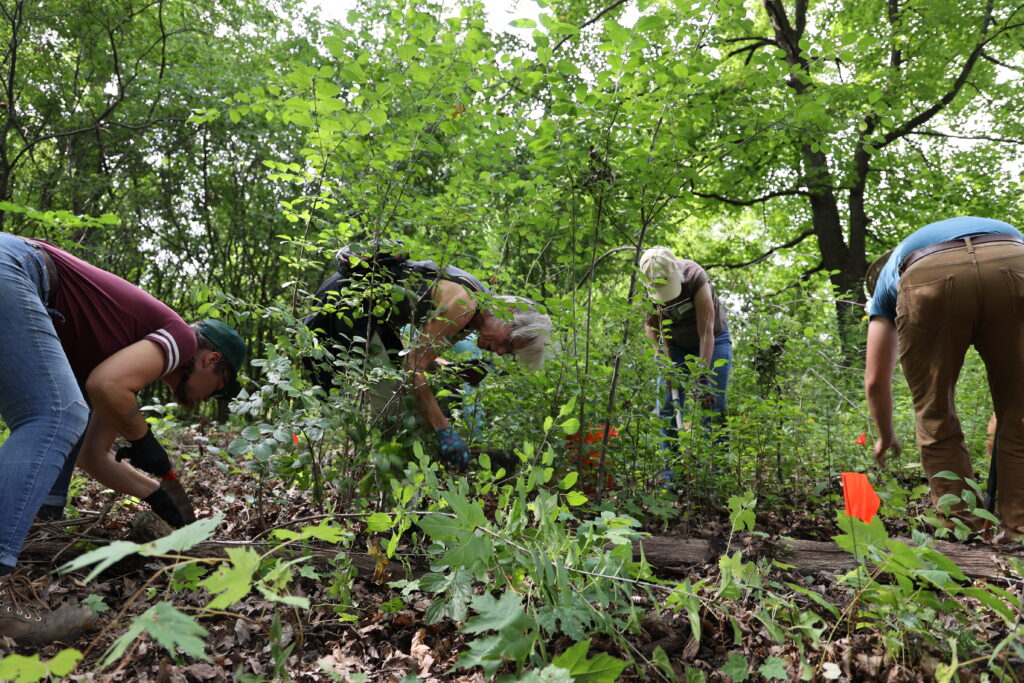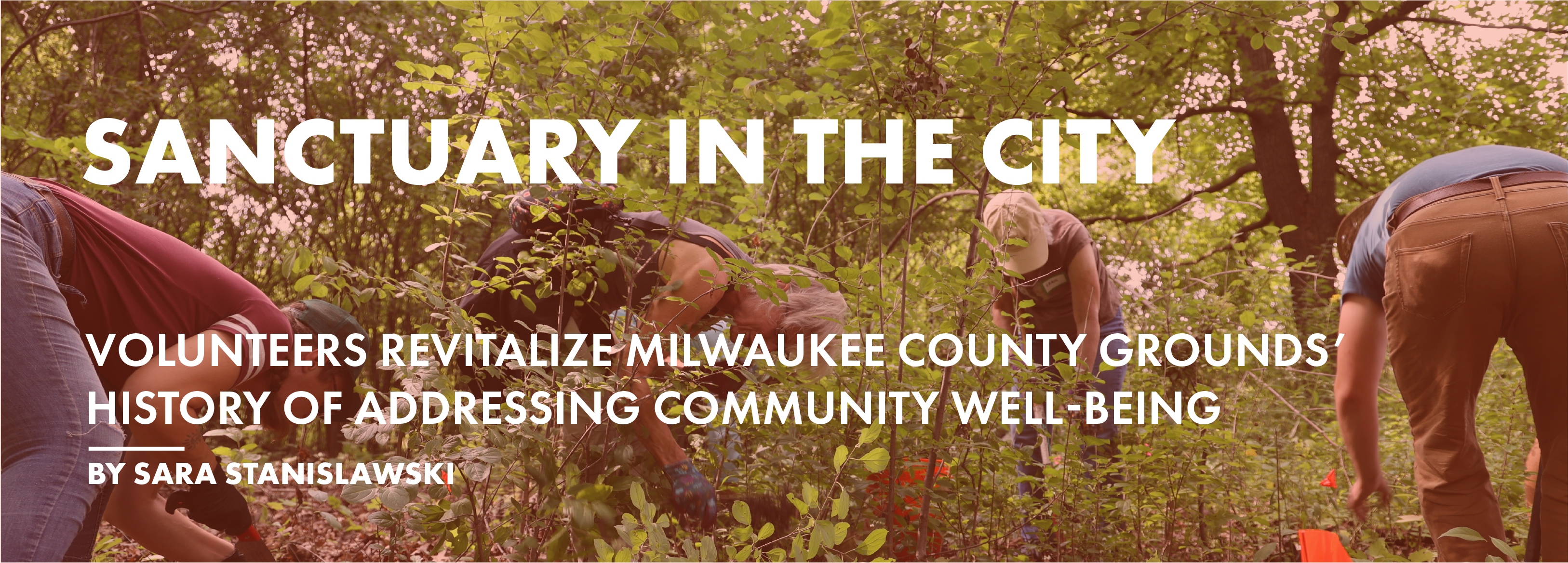Acorns hit the forest floor, squirrels rustle in the leaves and traffic from Interstate 41 blends into a constant hum. An occasional siren wails from an ambulance at the nearby Milwaukee Regional Medical Center in Wauwatosa, a suburb west of Milwaukee.
The ruins of what was once the Milwaukee County Insane Asylum, first established in 1878, the old-growth forest and nearby prairie of County Grounds Park offer a sanctuary from the surrounding city.
The Friends of County Grounds Park volunteer group works with the county parks department to protect the park’s natural areas and support wildlife and community health. The group formed in January 2020 after Wauwatosa rezoned a section of county land, including a forested area known as Sanctuary Woods. Giving it conservation status helped curb potential development there.
After the rezoning and years of development debate, the group’s volunteers are working to revitalize the grounds’ history of fusion between its natural areas and use for community well-being.
“In the middle of urban Wauwatosa, to have this old-growth woods as a sanctuary for people to go to, it means as much today as it did 140 years ago,” says Jonathan Piel, president of Friends of County Grounds Park.
On a Saturday morning in September, a group of Milwaukee-area residents practice Asahi, a Finnish health exercise that uses slow movements and coordinated breathing. They stand on the remaining foundation of a pavilion built by patients of the former hospital in an area of Sanctuary Woods called the Men’s Grove.
Sue Schaefer, a volunteer Asahi instructor for the Friends of County Grounds Park, led the session. The practice benefits people of all ages through its movements that strengthen, stretch and relax peoples’ bodies, Schaefer says.
“Doing Asahi in the Men’s Pavilion is a great way to carry on the intent that area was developed for as part of the hospital,” Schaefer says.

Mental health care history unearthed
Piel grew up on Wauwatosa’s north side in the 1970s, so he didn’t discover Sanctuary Woods until walking his dog in 2016. He came across the remaining foundation of a structure covered with leaves, graffiti, trash, broken glass and a fire pit — a place he now knows as the Men’s Pavilion.
Piel started researching the land’s history. He came across an online version of a book from 1916 with about seven pages describing the “Milwaukee Hospital for Insane” in Wauwatosa, first called the Milwaukee County Insane Asylum when it was established in 1878.
The hospital made efforts to beautify its grounds by adding a 1.5 acre artificial lake, according to the book. The grounds included sunken gardens, the Men’s Pavilion, stone steps leading down to a ravine in an area called the Women’s Grove and other features, which the group’s volunteers have cared for after decades of neglect.
Before the mental health hospital opened in 1880, those staying at the general hospital on the county land were called inmates with small rooms called cells, Piel says. A fenced yard “innocent of any tree, shrub or flower” provided their only space for recreation, according to an 1865 editorial written by Dr. Fisk Holbrook Day, a physician and later superintendent of the hospital.
“This is not far from incarceration,” Piel says.
When Piel gives history tours, he encourages participants to reflect on the site’s history of use related to mental health. They have a few minutes of quiet as they make their way through the Women’s Ravine.
“We have these citations from 1916 about women using this space, which was a safe space in the Women’s Grove [where] they could be in communion with nature and be in sufficient quiet to be in touch with themselves and how they feel,” Piel says. “We’re going to do the same thing on that tour today.”
Dr. Michael McBride, a psychiatrist at the Veterans’ Administration Medical Center in Milwaukee, first explored the area with a classmate from the nearby Medical College of Wisconsin in 1989. An abandoned building from the hospital, also called North Division, still stood. Before it closed, the hospital served patients with acute mental illness, McBride says.
Two years later, McBride talked with archaeologists who were called to a forgotten cemetery discovered during the construction of a new medical building on the county land. McBride decided to research the cemetery and the area’s history as part of a public health elective.
McBride continued to give talks and tours to community members and medical students about cemeteries on the county land, including the Milwaukee County Asylum Cemetery in County Grounds Park.
“Being a psychiatrist who had worked at the county mental health complex and trained there, it became near and dear to me to learn about that history of how we cared for the mentally ill throughout our history,” McBride says.
One of the hospital superintendents, Dr. Moses White, recognized patients should connect with nature and restore their health away from the pressures of urban America, McBride says.
Findings in current psychiatric literature reflect this — as people have more exposure to greenery, they tend to have better mental health outcomes, McBride says.
“A lot of us know that intuitively, but those studies are just coming out now,” McBride says. “Well, this was done [nearly] 150 years ago through the grounds that were cared for and designed for these patients.”
Woods protected from development
The Wauwatosa Common Council voted to rezone 58 acres of county land, including Sanctuary Woods, from medical use to conservation status in December 2019, adding the land to the existing 55 acres of County Grounds Park.
Though developing the land became increasingly attractive as a source of tax revenue and because of its proximity to the regional medical center, Piel says citizens volunteered their time and effort to convince elected officials to protect the land.
“It was over 20 years that people continued to go to meetings and talk with the aldermen and try to convince them that it was better off for people to keep it a natural area, that the doctors who ran the mental health hospital knew that that type of environment was good for their patients,” says Sheila Nolte, who grew up in and lived near Wauwatosa while the hospital was still open.
Before the rezoning vote at a common council meeting in December 2019, Piel said that if this land became parkland, citizens would be ready to steward it.
“There was some lament that there just wasn’t enough inertia around this and who was going to take care of it,” Piel says. “We have taken care of the park in the four years since then.”
Volunteers have together spent nearly 1,000 hours caring for the park in 2023 as of November, Piel says. Though the land’s current zoning protects it from development, it could be rezoned again.
“We need this green space for the mental health of the community,” McBride says.

Revitalized role in community well-being
Volunteers have removed decades of dirt, leaves, broken glass and fire pits from the remaining structures of the hospital that closed in the 1970s.
The volunteers, including many middle and high school students, also remove invasive buckthorn to support the old-growth forest and make its spaces less hidden. The group also installed signs describing the space’s history.
“It really made this space much more usable and approachable for anybody who wants to use it for a mental health experience,” Piel says.
Volunteers have also planted 200 trees in recent years in a field on the park’s south side to extend the forest. Nearby developments, including the Watertown Apartments, Ronald McDonald House and Milwaukee Regional Medical Center, matched funds the group raised for the planting in fall 2022.
“We lean right back into [our neighbors] to find ways to be able to be collaborative, win together and feel like we all have an invested stake in the park,” Piel says.
Hoppe Tree Service, a local company, also volunteered its time and equipment and coordinated with the parks department before the planting in 2022 to help remove dead ash trees and water the newly planted trees.
“Our mission is taking care of people and their trees, and part of that’s being really active in the community,” says Freddy Hoppe, a co-owner of Hoppe Tree Service who grew up in Wauwatosa. “So that’s what kind of drew me to this group is a place I was familiar with … a place that could go away if people stop caring about it.”
The Friends of County Grounds Park group also hosts events aimed at enhancing health, like the Asahi sessions.
Nolte, a volunteer member of the group and a certified forest therapy and nature connection guide, also leads Shinrin-Yoku walks, a term that first emerged in Japan in the 1980s. Often called forest bathing in the U.S., the practice helps people connect with nature, open their senses, and slow their bodies and minds, Nolte says.
An article published by the Environmental Health and Preventive Medicine journal explains that Shinrin-Yoku can reduce stress hormones and help people with depressive tendencies.
When participants go to the Men’s Pavilion, Nolte says she often reflects on how many people, including patients, must have sought shelter from rain or met friends there — it’s a spot where people continue to gather today.
“Every time I’m out there, I can’t not be in the history and have respect for the people who were there and the people who helped create that sanctuary for them,” Nolte says.
